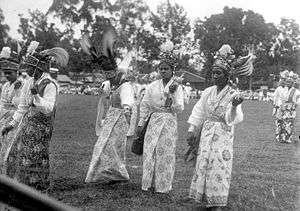Ambonese
|
Ambonese women performing a dance on Queen's Day, 1921 | |
| Total population | |
|---|---|
| (354,000[1]) | |
| Regions with significant populations | |
|
Indonesia Ambon Island (304,000)[2] Netherlands (50,000)[3] | |
| Languages | |
| Ambonese Malay, Indonesian, various Malayo-Polynesian languages | |
| Religion | |
| Christianity (predominantly), Islam | |
| Related ethnic groups | |
| Melanesians, Polynesians, Moluccans |
The Ambonese, also known as South Moluccans, are an Indonesian ethnic group of mixed Austronesian-Papuan origin. They are mostly Christians or Muslims. Ambonese are from Ambon Island in Maluku, an island group east of Sulawesi and north of Timor in Indonesia. The predominant language of the island is Ambonese Malay, also called Ambonese language. It developed as the trade language of central Maluku, and is spoken elsewhere in Maluku as a second language. Bilingualism in Indonesian is high around Ambon City. They are an ethnic mixture of Southeast Asians and Melanesians people of New Guinea, as they speak a Malayo-Polynesian language.[4]
A typical Ambonese village consists of about 1,500 people who live in houses of woven sago leaves or plastered bamboo on stone foundations; they cultivate surrounding hillsides.
The Ambonese have been heavily influenced by Islam and Christianity, and indigenous customs have largely disappeared.
References
- ↑ "Ambonese people". Joshua Project. Retrieved 2014-09-17.
- ↑ "Ambonese in Indonesia". Joshua Project. Retrieved 2014-09-17.
- ↑ "Ambonese in Netherlands". Joshua Project. Retrieved 2014-09-17.
- ↑ James T. Collins (1980). Ambonese Malay and Creolization Theory. Dewan Bahasa dan Pustaka. ASIN B007FCCSKG.
| Wikimedia Commons has media related to Ambon. |

